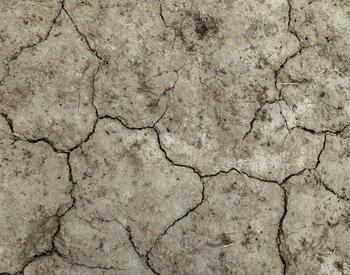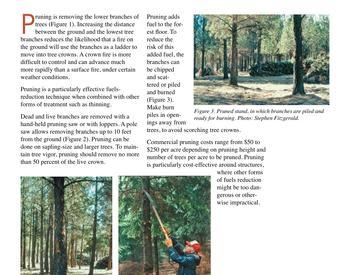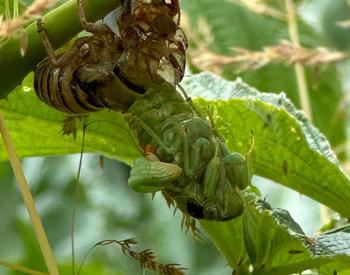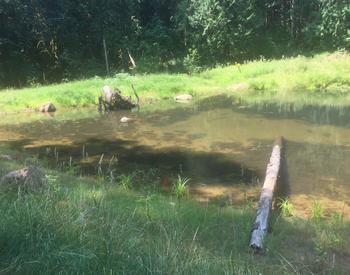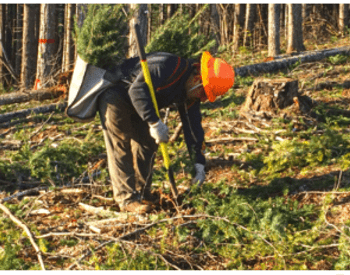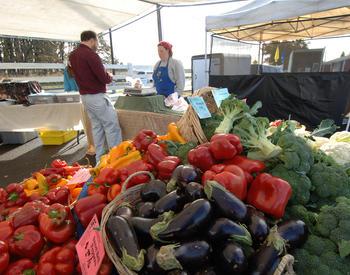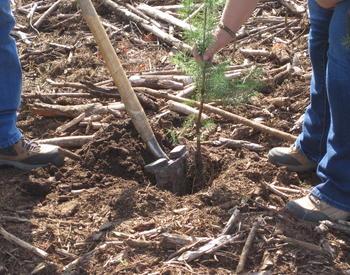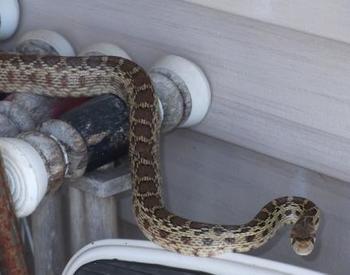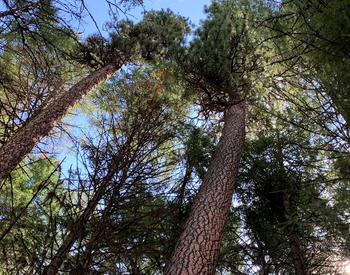Transcript
From the Oregon State University's Extension Service, you are listening to In The Woods with the Forestry & Natural Resources Program. This podcast aims to show the voices of researchers, land managers, and members of the public interested in telling the story of how woodlands provide more than just trees, they provide interconnectedness that is essential to your daily life. Stick around to discover a new topic related to forests on each episode.
Jacob: Hello everyone and welcome back to In The Woods Podcast presented by the Forestry & Natural Resources Extension Program at Oregon State University. I am your host, Jacob Putney, Assistant Professor of Practice and Extension Agent in the College of Forestry. This month's episode is going to cover forest health, including why it's important and how it can influence the growth and development of woodlands. Our guest today is my colleague, Dr. Dave Shaw. He is a biologist and forest health specialist with the Forestry & Natural Resources Extension Program and Professor in the College of Forestry at Oregon State University. He's also the director of the swiss needle cast cooperative, a research cooperative focused on maintaining the health of managed Douglas-fir. So Dave, would you like to give an introduction and tell us a little bit about yourself and some of the work that you do?
Dave: Sure, again my name's David Shaw, I'm a forest health specialist so forest health is near and dear to my heart of course, and I have a PhD from University of Washington. I got that way back in 1991 and I worked at field stations for around 15 years or so before coming to Oregon State University in 2005. I work here again, as you said, as director of the swiss needle cast co-op. Swiss needle cast is a foliage disease of Douglas-fir and it's been affecting productivity of Douglas-fir in particular geographic areas of the west side of Oregon and I work with a range of forest insects and diseases and abiotic factors which influence tree mortality and growth and productivity of our forests.
Jacob: Yeah well I appreciate you joining us today, Dave, I've had the privilege of knowing you for a while now, back when I was a student and now as colleagues in the Extension Program. So I guess we'll kind of dive right into it, so when we say forest health you know what does that mean and what kind of things does that really include?
Dave: Yeah that's a really interesting question because I struggle with that a lot. Forest health I think is everything I mean everybody feels like they want a healthy forest but when you really get down to defining what a healthy forest is it can become kind of complicated, and I think it's really intertwined with people's values and what they value about forests and so their values really drive what they feel like a healthy forest is. So, but a lot of the kind of things we hear about when we talk about what a healthy forest is, it's something that's resistant and resilient to insects, diseases, fire, drought, these kind of things. It's sustainable, it's provides ecosystem values, it provides landowner values - timber, in some cases wildlife and others - and so it often is really in the eye of the beholder, what a healthy forest really is.
It often gets complicated about you know in what a I would consider like tree health versus forest health. So everybody can agree, you know, whether a tree has a root disease, or a canker, or a dead top, or some other factor that's causing it to be unhealthy, but when it comes to forest health some of these kind of things are really you know - dead tops, cavities, rot, that kind of stuff - is really important to wildlife. So depending on your objectives, the landowners, you know a healthy forest might be a young vigorous free-to-grow plantation with minimal mortality, minimal growth losses. Other people think a healthy forest is a beautiful old-growth forest with large, old trees and high biodiversity and these kind of things, and sometimes those conflict with each other.
But to quote an old pathologist from back in the day, Paul Manion, he used to say that a healthy forest has a healthy amount of disease and he was a forest pathologist and in that sense it's a healthy forest would have habitat for wildlife but it's also going to provide ecosystem values that the landowner would want. So, it's kind of complicated from that point of view. I was googling around on the web and stuff and our neighbors to the north, Washington DNR, had put a lot of thought into the forest health and they have a really good forest health program, a strategic plan and everything, and they defined forest health in this somewhat long definition. But I thought I'd read it just to give you a sense of what everybody thinks about forest health. They define forest health as the condition of a forest ecosystem reflecting its ability to sustain, structure, function, and process resilience to fire, insects, and other disturbance mechanisms and adaptability to changing climate, increasing drought stress, and capacity to provide ecosystem services to meet landowner objectives and human needs.
You know, wow, that's a healthy forest, but I think for most people to be honest I think a healthy forest doesn't have a lot of dead trees. Most people when they look at a forest and if they see a lot of dead trees they feel like that's unhealthy. But you know when you think about ecosystem processes like, lodgepole pine for example and the mountain pine beetle, you know mountain pine beetle rolls through most lodgepole pine stands when they reach a certain age and susceptibility and you know can cause extreme amounts of mortality. You know 80 percent of the overstory might be killed during a mountain pine beetle outbreak. But if you think about the cycle of you know mountain pine beetle over millennia you know this has been going on for a long time and there's a time when yeah 80 percent of the overstory's dead, but you know this is going to change as it succeeds back through its various successional sequences.
So forest health can get really bogged down in some of these kinds of discussions and definitions and that kind of thing. But in general I think you know these ideas of sustainability, meeting values, and particularly when it comes to fire is where forest health has become really important. On the east side, much of the restoration efforts are to create you know forests that are much more resilient to fire, or resistant to fire, and that is in everybody's interests to protect communities and properties and that kind of thing. And for timber growers that are have a commercial crop on the ground, protecting that from fire, completely, you know is really important because of the economics involved. So you know forest health is really a value-laden sort of concept, but I think generally we all agree that we want healthy forests and we want to manage forests so that they are providing values, particularly from economic and wildlife perspective. I guess that's kind of a rambling definition of forest health, but that's what happens when you get to talk about forest health.
Jacob: Oh no, it sounds like it just includes so many different things, and it sounds like people can value so many different things in their forest. So they you know they might view forest health a little bit differently than somebody else.
Dave: Right.
Jacob: So you know we talked about how like mountain pine beetle, for example, has kind of worked its way as a component of lodgepole pine stands. So how does forest health you know influence kind of the development of these stands, and think about things like natural disturbance and forest succession, that we kind of talked about in our last episode on how forests grow.
Dave: Yeah so, you know, natural forest development you know is influenced by insects and diseases and we tend to think of native insects and diseases as being part of the system. You know in natural forests they may or may not really be creating unhealthy conditions. When we begin to manage forests for economic objectives or other objectives then some of these native insects can then become pests because they're causing growth losses or mortality of crop trees and it can be you know that's where we really get into conflict with our native insects and diseases. But managing forests to minimize losses to our native forest insects and diseases is often an objective of forest managers that are trying to you know grow commercial crops. In the, you know, more ecosystem management's point of view, tolerating a little bit more of this - having more cull in the forest basically, heart rot, top rot, and these kind of things, - that are really important to wildlife, but would reduce the value of the log. You know, ends up being sort of a cost-benefit analysis kind of thing.
But as forests develop, you know, there's lots of differences in this in terms of the west side versus the east side is sort of the common sort of contrast that we make in Oregon. Where our dry forests tend to be much more you know we tend to have more big time disturbance agents on our west side than we do on our east side - excuse me on the east side than we do on the west side. You know with bark beetles, mountain pine beetle, western pine beetle, fir engraver, Doug-fir beetle, on the east side can be dramatic, particularly the mountain pine beetle, versus - and some of the defoliators like western spruce budworm and tussock moth can be really dramatic on the east side. Whereas on the west side we tend to have more localized kind of outbreaks of beetles. We tend not to get the huge amount of mortality that might be caused on the east side. We tend not to have really big defoliation events on the west side and things like swiss needle cast along the coast is really important.
The thing that really strikes me about you know there's a contrast in my mind between these native insects and diseases versus invasives, and invasives I think really strongly influence forest health in my mind and that's my bias and that's my value to be honest. But sudden oak death has a toehold in Oregon down in southwest Oregon, it's killing tanoak and affecting other species in the forest. It's affecting the export of logs from some of our coastal docks. We have Port Orford cedar root disease, another non-native invasive, that has invaded the Port Orford cedar native range for Port Orford cedar and is killing trees along riparian areas and upland areas. Swiss needle cast is actually a native, caused by native fungus, and that's an interesting situation where the Douglas-fir plantations in the coastal strip have really seen an uptick in swiss needle cast and that seems to be sort of a perfect storm kind of thing where young plantations are planted in these really productive areas and swiss needle cast, and the climate for the disease, particularly warm winter temperatures and warm mild temperatures, and then leaf wetness during May, June, July, August, from fog and drizzle and that kind of thing really sets up these plantations for a foliage disease epidemic, like we're having. Then so you know there's a lot of contrast though you know those kind the non-native invasives, like white pine blister rust is another one, it's a major, major issue in our five needle pines. Whitebark pine at high elevation, western white pine at you know all through the state, and sugar pine down in the southern part of the state are all being dramatically hit by this non-native invasive. So I think when we think about forest health, the threats I see and really the largest impacts to forest health, would be from non-native invasives; and that because they can almost you know remove a species from commercial viability, and it can really cause dramatic changes to our ecosystems and our forest ecosystems by removing species and that kind of thing.
The one other thing I just wanted to mention is with climate change. There's some conjecture that our native insects could become quote-unquote you know more invasive or could you know increase their impacts to forests that would be outside the sort of range of normal activity. So there's some concern that some of the bark beetle activity we're seeing, in particular, is outside the range of normality and that might be you know being affected by some of our longer, hotter growing season. Our big fear right now is drought, and drought is what sort of keeps me awake at night. I'm really worried about weather and drought is it. We're in what some people call you know a 20 year, for the last 20 years, we've been unusually dry and this is starting to influence forest health and tree mortality all through the state. We're seeing it all through the Douglas-fir forests on the I-5 corridor, have been really taken a hit from what we think is drought-mediated effects. And then on the east side, we're seeing it all through the forests on the east side, and then at higher elevations in the Cascades our snowpack issues really influence the health of of the montane, true fir forests like silver fir, noble fir, and they can be really influenced by drought. So drought, and these increasing drought, is something that's really worrisome to me and I'm hoping that it starts raining or continues to rain all winter.
Jacob: So, you kind of talked about how some of the native pests, you know they can be an important component of some of the natural progression of some of these stands and how there's a you know healthy amount of forest health concerns, whether it's an insect or a disease all the way to some of the invasive species and how detrimental they can be to some of these areas, particularly like sudden oak death. My next question here is, when do some of these, whether it's a disease or a pest, when do they start to get on the radar? And when do they start to become an actual you know a concern? Like when they first show up? Or you know when they start to cause you know widespread mortality? Can you talk a little bit about that?
Dave: Yeah it's a little bit variable because there might be a history around some of these invasives, where they're already on the radar screen. So one of them that we're on the lookout for right now is the emerald ash borer, and the emerald ash borer is considered, it only emerged in around 2000 back east, but over the last 20 years it's become the most expensive invasive species to invade North America on record. So that puts it in a sort of class all of its own and it's really been removing ash from most forests back east. Several different species of ash. We have Oregon ash in our forests here, particularly in the Willamette valley and along the you know to the south, and we are really fearful that, that insect is going to come. So we already know that one's on our radar screen, we're trying to protect our forests, we have early detection set up, we have plans in place, that when it arrives what we're gonna do.
Whereas some of these other ones sort of sneak in and surprise you and then we don't really understand you know what was going on. Like sudden oak death for example. When it emerged in California they were clueless about what it was. They had no idea, it hadn't been, didn't even have a scientific name yet. The causal agent with this, Phytophthora ramorum, and it took them you know five-, ten-years to really get a handle on what it was. So that was a completely different situation in that sense where we had this non-native that nobody knew what was going on and it was just this unusual mortality and that really you know, so that got on the screen really quickly. So it really depends on you know whether it's a known, that we're sort of ready for, or not ready for but it's on our watch list, versus some of these ones that arrive and nobody knows what's happening. There's a new shot hole borer, it's an ambrosia beetle, that's associated with oak mortality that's emerging in California, and we're really worried about that one. But it took them a while to figure out what was going on with that one down in California, but they've described it now and we have this scenario we're watching but we're hoping it doesn't you know make its way to Oregon. So Oregon's doing, you know other than white pine blister rust and sudden oak death and Port Orford cedar root disease, those are some of our major invasives. We also have some on the coast the you know spruce aphid is another non-native insect that is affecting our Sitka spruce for us along the coast.
But to sort of get back, circle back, to your question in general when we start thinking about forest health, we tend to think about the rate of mortality within a forest stand and we get this data from permanent plots. So Forest Inventory and Analysis, the U.S. Forest Service program, has this grid of plots all across Oregon, Washington, all across the USA, including Alaska and Hawaii, and they monitor tree growth and mortality and productivity and it gives them some really good insight into forest health. But what we think about is the rate of, the annualized rate, of mortality or what percent of the forest is dying each year. So typical forests you know that we think are healthy have a rate of mortality under about you know three to five percent. Typically you know an old growth forest might only have less than one percent mortality a year. A young you know forest that is in a competitive exclusion phase where you know it's self-thinning, rate of mortality might be up to three to four percent in a stand like that. But eventually when it gets to be 150 years old, the rate of mortality might drop down to you know under two percent. So we have plot networks that support FIA, and those plots are measured you know every five years or so. So after about 10 years we can develop, you know we can get a sense of, what the rates of mortality are. When you know one of our general ideas is when we see the rates of mortality you know starting to go over five percent or so we really start to get a little worried about what's happening and that gives us another way to sort of get a perspective on you know are our forests healthy or not. You know this rate of mortality idea. That seems to be, it's pretty objective in that sense, in the sense that you know it's not really, there's no values there, it's just the facts kind of thing.
Jacob: In Oregon we fly aerial surveys too right? To kind of map some of the different mortality events and try to identify like disease centers and things like that.
Dave: Oh absolutely! And you brought up a really important monitoring. So you know our forest health programs in Oregon are supported by the Oregon Department of Forestry and the U.S. Forest Service - their forest health protection group. They both have really great people, really good programs going on, and each year they fly the aerial survey. The aerial survey, basically what they're doing is they take an airplane and they have observers sitting in the airplane, typically two observers with sketch maps, and they're geo-located and everything, and they fly over the state and they draw polygons around mortality patches and defoliation patches. So we get a quantitative idea of acreage of forests that are being either defoliated, or where we're seeing mountain pine beetle activity, or various other activities that are visible from a plane. You know some of the diseases and that kind of thing are very difficult to observe from the plane, so mostly what we see from the plane is insect damage. But really we see tree mortality and they count, they try to estimate the number of trees and they draw the acreage around the trees and that monitoring program is really fundamental to our understanding of forest health in the west, or actually throughout the whole country, but particularly in Oregon, Washington, California, Idaho, Montana, we really get a good sense of what's going on in the state from this monitoring program and it's really critical. Of course COVID has influenced that, and last year they weren't able to do their aerial detection survey so we have some a gap in our data, and it's looking like this year may be iffy also.
The aerial detection survey is also really important for swiss needle cast, and we do a spring survey for swiss needle cast that is separate from the summer statewide survey, where they fly every acre of the forest, every acre of forested area in Oregon. But the swiss needle cast survey we do in spring and we fly the coastal forests and we estimate symptomatic trees. So for example the last survey we were able to pull off was in 2018 and we had about 420,000 acres of Douglas-fir plantations that were, or Douglas-fir forests, that were showing visible symptoms of swiss needle cast for example. So that gives us a really good estimate of where the disease is an issue and on what scale is really an issue so those are really important monitoring programs that help with forest health assessment.
Jacob: Yeah I really enjoy seeing some of the results from those surveys and how it changes from year to year. The group that you mentioned, the Oregon Department of Forestry and the forest health group at the Forest Service there, they actually publish a you know forest health report every year too and I always look forward to kind of reading through that to see.
Dave: Yeah that's a really good document, it's called Forest Health Highlights is the name of the document. They do it for each state, well they do it in region six which is Oregon and Washington. They do it for Washington and Oregon and we have an annual document that comes out called Forest Health Highlights, and it's really one of the most important documents in my mind that really is an assessment of the statewide conditions. I think that is really relevant to forest managers because it's regionally based and they publish these maps online so that you can go online and look at your property and see whether they've been surveying you know foliage diseases or defoliators or mountain pine beetle outbreaks and picking up you know mortality. More recently they've been dealing with the drought associated mortality and it's very difficult for them to assess the cause of those dead trees so a lot of times they're having to map it as unexplained tree mortality or hypothesize drought mortality and that kind of thing.
But we've been seeing more and more of that show up on the Doug-fir along that I-5 corridor.
Jacob: What I'll do is I will make sure and I will get those links to that Forest Health Highlights into that website and I will put that on our class resources.
Dave: Yeah, great.
Jacob: Or, podcast resources on our website. So, we work here in Oregon, and I know you mentioned you know a lot of different pests and diseases already, but if you could pick three of the most influential in Oregon currently, which three would you pick? And it could be anything from abiotic, biotic, a pest, an insect, a disease.
Dave: Oh wow, that's a tough on. Well we haven't talked much about fire, but as we know fire can be very destructive, particularly to commercial forest plantations where once you know they can cause really a lot of economic hardship for commercial forest plantations. So I have to think of fire you know, now we all know fire's a natural you know fire occurs naturally, but it's really complicated nowadays because of our drought, our long-term intensive drought, weather conditions that might accentuate fire, and then where the fire is burning and what the start of the fire you know what started the fire. You know whether it's human caused or whether it's you know lightning caused and that kind of thing. So fire you know is a major forest health concern, particularly from the you know people who are investing in their forests or are living in the forest you know to protect human well-being, communities, and that kind of thing. Fire's probably on the radar as one of the most important forest health issues. I'm not a fire ecologist, I'm you know a biologist, and so my focus tends to be on the biota that's influenced forest, but fire is really key.
I'd say drought is the other one that really is influencing our forests right now and we've seen in California they had an epic drought, they called it a hundred thousand year drought kind of thing, anyway we saw incredible amounts of tree mortality along the western slope of the Sierra Nevada associated with this drought you know it was a unprecedented mortality event after a four-year drought that was extreme. So that drought is one of the biggest threats I think to forests right now.
Then sort of you know to lump all the invasives together, I would say invasives are the other you know really key threat to forest health right now. You know when we compare ourselves to like New York state or something, we don't have a lot of invasives compared to them, but our invasives are slowly accumulating and we're really starting, we're really getting worried, about what the potential for invasives are in Oregon. I think if I was to pick, if you don't mind if i keep on with that, if I was to pick some native insects to diseases, you know of course it's swiss needle cast - foliage disease in western Oregon - and bark beetles and defoliators - in eastern Oregon - are probably the biggest forest health threats to you know land owners. But you know the drought thing has really been complicated because people are having these trees die and there's, they don't know what to do with them you know they want to fell them for hazard purposes but they can't you know sell them, there's a glut on the firewood market and that kind of thing.
Jacob: Kind of on that last note that you mentioned there, so say I own a woodland right, and maybe I have some mortality or I'm kind of concerned about a forest health issue, what are some things that I could do to kind of try and identify whether it's you know an insect, a disease, or drought. Is there something I can do? Or is there someone I can call and talk to about that?
Dave: Well it's complicated depending on what your goals are. You know OSU Forestry Extension, and our master woodland manager program, is probably one of the you know front lines in terms of the potential to get an evaluation of your property. Then I think the Oregon Department of Forestry, stewardship foresters, also tend to be really locally savvy and know what's causing local tree mortality. Then in terms of resources and that kind of thing, there's the Oregon Department of Forestry has a really great website and the forest health protection of the U.S. Forest Service has a really great, their region 6 group, has a really good website also for sort of more in-depth information and plus they summarize the aerial detection surveys and what are the current you know issues that people are seeing. I think in terms of, just one of the things is really to walk your property and get a real sense of how extensive the mortality really is. Is it just one pocket of trees? Is it scattered throughout your property? It doesn't seem associated with a certain habitat type, you know a ridge top, or a low elevation, or a roadside, and getting a sense of just your property is really something that is really important.
Another option for having, you now assessing what's actually happening on your property depending on the severity and your concerns and where your goals are, whether it's a commercial goal or a biodiversity goal, would be to have a professional forester come visit your property and walk the property with you. They tend to really be savvy about what the local issues are in terms of tree mortality, they can identify root rot and bark beetles and that kind of thing. The other groups, depending on how much property you have or whether you just have a few individual trees near your house, then you probably want to consider an arborist. Arborists are usually very savvy about what's affecting trees but if the trees are on property where they could be a hazard it's really important to get an arborist to evaluate the hazard potential to your house or to your property you know where you're parking your car and these kind of things. That can be really important so depending on the scale of the mortality and what you want to learn about the mortality.
Oftentimes if you connect with our Extension Foresters, or myself the forest health specialist, you can send photographs and send a series of photographs with your question. Typically it's really nice to get a close-up of the tree so that the we can identify what kind of tree it is, foliage and bark or whatever is really important you know, and then a sort of a landscape setting type photo, or a context type photo, and then close-ups of what you think the damage is. Whether it's down you know at the bole of the tree or whether it's up higher, if you can get some a series of photographs often are really helpful in assessing you know via email or whatever you know what might be going on. So that can really assist, and we also have an Ask an Expert program [Now called Ask Extension], and that's an online program through you know nationwide Extension Service. You can get some pretty good information from there too. The OSU Extension Service has experts across all these fields, and we have you know entomologists and pathologists at Oregon State University who participate in Ask an Expert [Ask Extension], and who will also answer questions. In those cases it's really rare to get those people to come visit your property, so that's where having photographs and explanations and that kind of thing.
Also depending on the whether you're really curious about what's causing the disease, or insect or whatever, we do have the OSU Plant Clinic. Has a program where you can send samples you know and it's really common for people in agriculture to send samples to these labs and they can identify insects and they can do analysis on forest diseases. However, there is a cost with the forest disease evaluation, but I think we can get insect identification for free through that program.
Jacob: Yeah I'm glad you brought up Ask an Expert [Ask Extension] too, I think given you know the current pandemic that's another really really great resource, and especially emailing pictures too. Especially before I even, if I am going out to visit a site or something like that, having a picture first can give me a kind of a lead that I can do you know a little bit of research before I actually. You know or ask folks like you, who know a lot more about forest health issues than I do so.
Dave: Yeah there's some really good field guides and that kind of thing to identification of insects and diseases, but it takes a little bit of training, so they're not necessarily super helpful to just anybody to get one of these books. However with a little bit of you know training, which you can sometimes get through our extension programs, it can give you a lot of, then you can start to try to identify some of these yourself. There's a lot of resources on the web, it's incredible how many resources are out there in terms of field guides, and identification guides, and management guides. We have some excellent management guides you know in the OSU Extension Publications, has a series of, a really good series of publications on forest health, and managing forest health, and managing you know fire resilience and these kind of things, in our OSU Extension Catalog.
Jacob: Absolutely. Well I guess is there anything else that you'd like to tell us, Dave, about forest health? I think we really kind of dove into a lot here but any parting thoughts you have?
Dave: Yeah we've jumped around a lot I mean I guess you know with climate change, and drought, and invasives and there's a lot to be depressed about, but I remain reasonably hopeful that our forests are resilient. You know there are forest health issues, particularly you know on some of our eastside forest, where fire suppression has led to overstocked stands and we have you know a lot of changes in the structure and composition of the forest that makes them less resilient. But you know restoration forestry is all about restoring you know sustainability and resilience and resistance to some of these stands. So there are models for maintaining forest health and I don't think it's really anything, you know it's possible in 50 years I might not say the same thing, but right now I think we do have a lot to be you know happy about in terms of our forests and we are seeing some issues, of course, and we've gone into those. But I think we're still doing pretty well you know in Oregon with our forest health. You know we've numerous issues, but in general I think we're not as bad as other places around the globe. So from that perspective, I think you know Oregon is actually you know in a reasonably good place.
Jacob: Alright well thank you so much for joining us today, Dave. I know we kind of bounced around a lot of different topics, but ultimately I think we really barely scratched the surface on some of the different stuff we can talk about when it comes to forest health. So if you're listening and you have a question about a forest health topic that maybe we didn't cover today, please drop us a comment or send us a message on our website at blogs.oregonstate.edu/inthewoodspodcast. Dave maybe we can talk you into joining us again to talk a little bit more about something like swiss needle cast or mountain pine beetle.
*Transition to Lightning Round*
Jacob: Now as we start to wrap up here, we have what we call our lightning round, where we kind of ask each of our guests a series of questions. So the first one here is, what is your favorite tree?
Dave: That's a tough one for me but, you know I don't want to be too cheesy, but Douglas-fir is my favorite tree. It's just a phenomenal tree, you know it's the best 2x4 in the world. But you know this is a tree that can grow to a thousand years, can reach 300 feet high, it's just when I'm in the forest and I you know particularly with old growth Douglas-fir you know there's 10 or 15 of these trees per acre you know I'm just so wowed by them. I just love Douglas-fir. Plus it's you know it's our number one commercial crop on the west side and it's just a phenomenal tree, an amazing tree to me.
Jacob: Yeah it's hard to be in Oregon and not really appreciate the Douglas-fir. Alright so the second question I have here is, what is the most interesting thing that you bring with you in the field whether in your cruiser vest or other field kit?
Dave: Well I guess I never want to be in the field without my hand lens, and this is a magnifying lens where, you know some of my friends and I call it the world of 10x or the world of 20x. Where you know you just can't see things at that scale and having a hand lens really helps you know see the things that are difficult to see with the naked eye and it really brings things into perspective. So my sort of unique tool might be you know a magnifying lens, a hand lens.
Jacob: No I think that's a good one. Lastly you know what resources would you recommend to our listeners, I know we kind of covered that a little bit. Some of the resources that OSU Extension has and then some of the resources that the forest health program has at the Forest Service. Is there anything else you could think of just kind of as we're starting to close out here?
Dave: Yeah well, there's you know the web has really good resources. Our state resources, and our adjoining states, California Extension, Washington DNR, Idaho their state forestry group, Montana their state forestry group, and the federal offices there. Actually there's a lot of resources available to sort of delve into forest health and depending on you know what your level of interest is and what you're trying to find out. My two go-to websites are probably the Oregon Department of Forestry forest health group, healthy forest group, and then the U.S. Forest Service forest health protection website. Those are my two you know go-to things and then for us, I think locally the Oregon State Extension Catalog that has all the information, and then there's also the OFRI, Oregon Forest Resources Institute, is also has a lot of online information about forest health. I think they're a really good go-to group also. So you know just google around the web is a great way to find information, sometimes it can take you down a rat hole, but there's really good really good information out there.
Jacob: Well thanks again, Dave, and thank you all for listening to this month's episode of In The Woods podcast.
Thanks so much for listening! Show notes with links mentioned on each episode are available on our website blogs.oregonstate.edu/inthewoodspodcast. We'd love to hear from you! Visit the tell us what you think tab on our website to leave us a comment, suggest a guest or topic, or ask a question that can be featured in a future episode, and also give us your feedback by filling out our survey.
In The Woods is produced by Lauren Grand, Carrie Berger, Jacob Putney, Stephen Fitzgerald, and Jason O'Brien, who are all members of the Oregon State University Forestry & Natural Resources Extension team.
This podcast is made possible by funding from the Oregon Forest Resources Institute. Music for In The Woods podcast was composed by Jeffrey Hino, and graphic design was created by Christina Friehauf. We hope you enjoyed the episode and we can't wait to talk to you again next month. Until then, what's in your woods?
In this episode, Jacob Putney is joined by Oregon State University Extension Forest Health Specialist, Dave Shaw. They discuss a wide variety of forest health topics such as drought, insects, and disease, and the influences these agents have on individual tree and forest growth.
